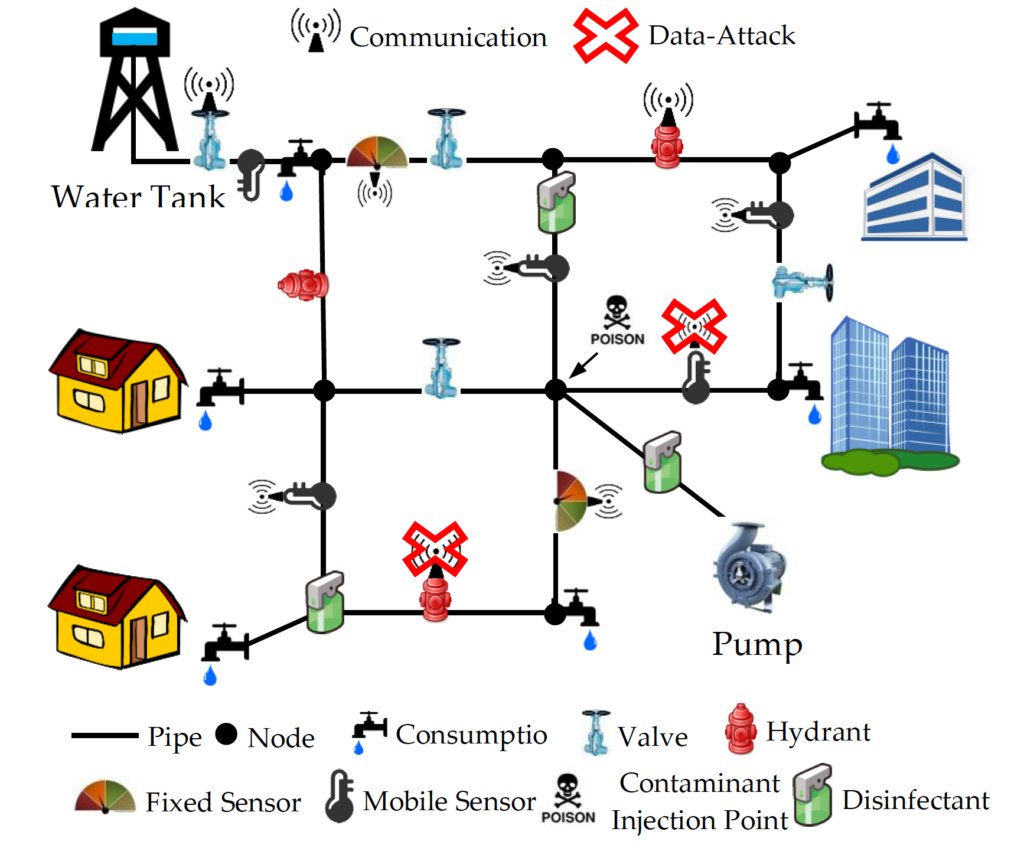Cyber-Attacks Mitigation in Water Networks
Modern water distribution networks (WDN) are evolving into cyber-physical systems comprising physical components, such as valves and pumps, and a cyber-layer of computing, sensing and communication devices. It is recognized that these cyber-components are vulnerable to malicious attacks that can range from sensor data manipulation to alteration of the control laws that govern the operation of physical components. Our recent work presents a data-driven, model-free optimization-based solution to the problem of detecting and mitigating cyber-attacks in WDNs. The method relies on unveiling low dimensionality components in the sensory data as well as on the sparse nature of anomalies a natural property of cyber-attacks against large volumes of data.

Specifically, we have competed in the Battle of the Attack Detection Algorithms (BATADAL) competition that aims to investigate various approaches for the detection of cyber-attacks in WDNs. The proposed methods are tested on simulated cyber-attacks on a realistic water network. We achieved the third place in the BATADAL competition, and our developed methods show the promise of early cyberattacks detection in water networks. The above figure shows the performance of the proposed algorithm which successfully identifies nearly all artificial cyber-attacks. Our objective in future work is to collaborate with local water utilities to implement this algorithm in their command centers. The reader is referred to this paper for more details regarding the algorithm we developed to detect and mitigate cyber-attacks on water networks.
Water networks are complex systems consisting of subsystems such as water sources, tanks, pumps, treatment facilities, and pipelines. In the past decade, due to the advancements in communication networks, WDNs have evolved into cyber-physical systems (CPSs), in which water utilities control their systems through communication technologies. Rapid development in the eld of water quality sensing is occurring as a bi-product of wireless sensing technologies, which in the past has been achieved by costly static sensors that are placed in strategic locations of the WDN.
More recently, mobile sensors that can travel inside WDNs have been developed, which has been proved to increase security of WDNs. Mobile sensors are being designed to sample and acquire data through wireless communication. Mobile sensors can sample water quality data ranging from 15 seconds to more than 5 minutes. The below figure shows a futuristic schematic representation of the physical and network infrastructure of WDNs with sensors (mobile water sensors) and actuators (pumps, hydrants, disinfectants) and attacks in the form of contaminations.
In this research, we focus on the water contamination problem. Controlling contamination is a major problem in WDNs—the recent calamity in Flint, Michigan is a living proof. The objective of this work is to develop control algorithms that minimize the spread of contamination and consequently the number of infected people through state-of-the-art mobile sensors and actuators.
Specifically, the focus here is on the dynamic sensor and actuator (SaA) selection in WDNs. SaA selection routines are very useful to this end, as operators have to execute mitigation strategies via a dynamically wise selection of SaAs. The decision variables in such a problem include optimal location of sensors, valves to be closed or opened, actuators that release disinfectant, and re hydrants flushing contaminants. We recently started developing algorithms for this problem with implementations on EPANET—a public domain, water distribution system modeling software package developed by the United States Environmental Protection Agency. We’ll post preprints of the work as soon as the work is completed.



